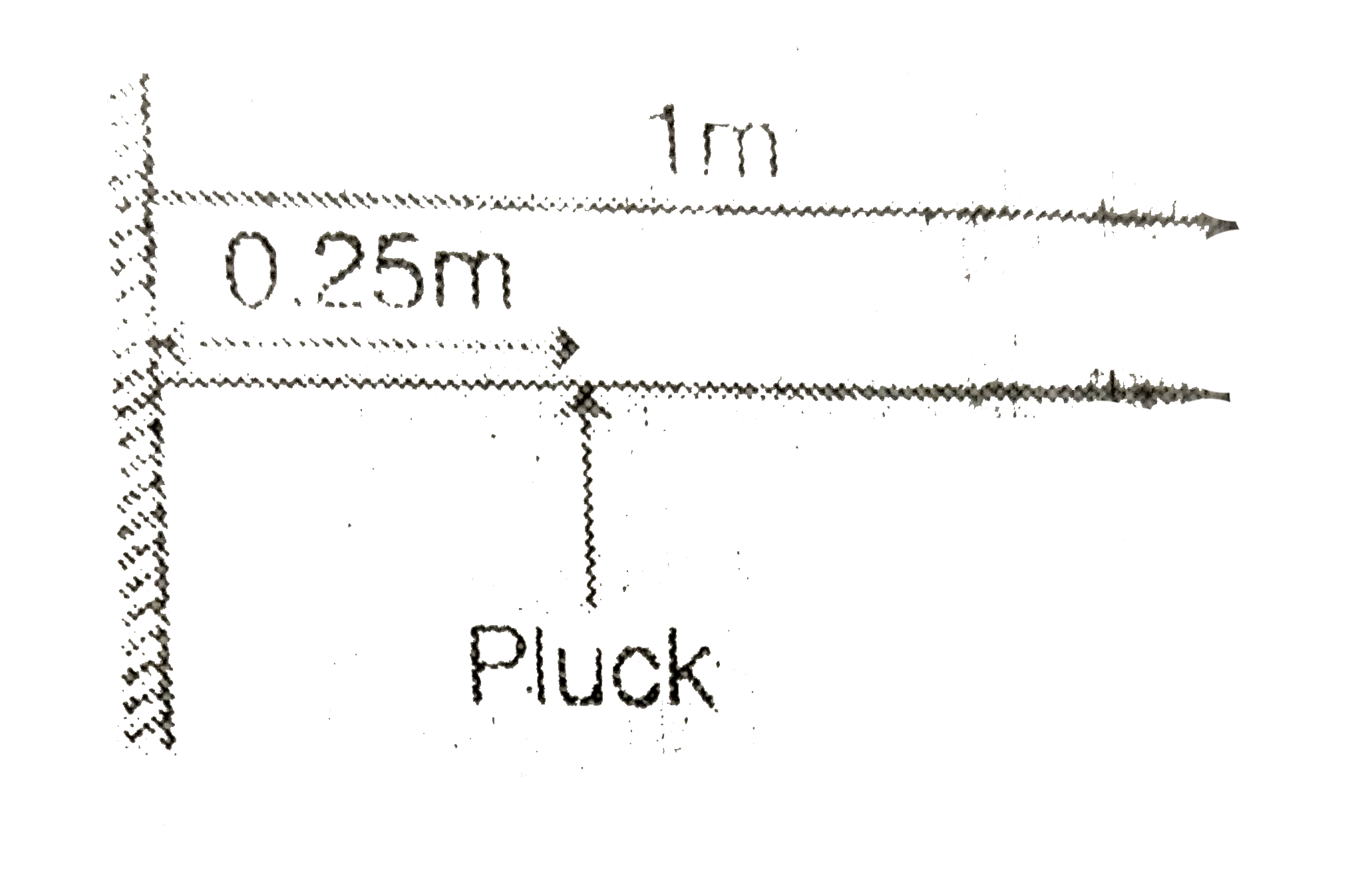A steel wire of length lm, mass 0.1 kg and uniform cross-sectional area 10−6m2 is rigidly fixed at both ends. The temperature of the wire is lowered by 200C. If the transverse waves are set up by plucking the string in the middle, calculate the frequency of the fundamental mode of vibration [Y=2×1011N/m2andα=1.21×10−5l0C]Solution in Telugu
f=12L√YAαΔθμ
Substituting the given values
Y=12×1√2×1011×10−6×1.21×10−5×20(0.1/1)=11Hz
Topper's Solved these Questions
- BOOK - AAKASH SERIESCHAPTER - WAVESEXERCISE - EXERCISE-IA (Theoretical questions :)85videos
WAVES
- BOOK - AAKASH SERIESCHAPTER - WAVESEXERCISE - EXERCISE-IA (Statement type questions:)18videos
WAVES
- BOOK - AAKASH SERIESCHAPTER - WAVE OPTICSEXERCISE - PROBLEMS (LEVEL - II)20videos
WAVE OPTICS
- BOOK - AAKASH SERIESCHAPTER - WAVES OPTICSEXERCISE - EXERCISE -III (POLARISITION)10videos
WAVES OPTICS
Similar Questions
Transverse waves are possible in solids only because
03:06View SolutionStatement(A) : Elasticity' property is necessary for the propagation of sound
Statement(B) : In a stationary wave, the rate of transfer of energy across any section is zero04:50View SolutionIn Young's double slit experiment the y co-ordinates of central maxima and 10th maxima are 2 cm and 5 cm respectively. When the YDSE apparatus is immersed in a liquid of refractive index 1.5. Find the corresponding y co-ordinates.
02:15View SolutionA ray of light is incident on the surface of a glass plate of refractive index √3 at the polarising angle . The angle of refraction of the ray is
05:24View SolutionA steel wire of length 1m , mass 0.1kg and uniform cross-sectional area 10^(-6)m^(2) is rigidly fixed at both ends. The temperature of the wire is lowered by 20^(@)C . If transverse calculate the frequency of the fundamental mode of vibration. Given for steel Y = 2 xx 10^(11)N//m^(2) alpha = 1.21 xx 10^(-5) per ^(@)C
View SolutionA steel wire is rigidly fixed at both ends its length mass and cross sectional area are 1m, 0.1 kg and 106m2 respectively then the temperature of the wire is lowered by 20∘C if the transverse waves are setup by plucking the wire at 0.25m from one end and assuming that wire vibrates with minimum number of loops possible for such a case. Find the frequency of vibration (in Hz). [coefficient of linear expansion of steel =1.21×10−6/.∘C and young's modulus =2×1011/N/m2]
04:46View SolutionA steel wire of length 20 cm and uniform cross-section 1mm^(2) is tied rigidly at both the ends. If the temperature of the wire is altered from 40^(@)C to 20^(@)C , the change in tension. [Given coefficient of linear expansion of steel is 1.1xx10^(5) .^(@)C^(-1) and Young's modulus for steel is 2.0xx10^(11) Nm^(-2) ]
03:26View SolutionA steel wire of length 1 m and mass 0.1 kg and having a uniform cross-sectional area of 10^(-6) m^(2) is rigidly fixed at both ends. The temperature of the wire is lowered by 20^(@)C . If the wire is vibrating in fundamental mode, find the frequency (in Hz). (Y_(steel)=2xx 10^(11) N//m^(2),alpha_(steel)=1.21 xx 10^(-5)//.^(@)C) .
View SolutionA steel wire is rigidly fixed at both ends. Its length mass and cross-sectionl area are 1m, 0.1kg and 10−8m2 respectively. Tension in the wire is produced by lowering the temperature by 20∘C. If the transerverse waves are some up by plucking the wire at 0.25m from one end and assuming that the wire viberates with minimum number of loops possble for such a case. The frequency of viberation (in Hz) is found to be. 1.11. Find the value of K. Given α=1.21×10−5.∘C−1.Y−2×1011N/m2
 03:18View Solution
03:18View Solutionस्टील का एक तार जिसकी लम्बाई 1 मीटर, द्रव्यमान 0.1 किग्रा तथा एकसमान परिच्छेद-क्षेत्रफल 10−6 मीटर2 है, दोनों सिरों पर दृढ़तापूर्वक बँधा है। तार का ताप 20∘C कम कर दिया जाता है। यदि तार को मध्य में कर्षित करके (by plucking) अनुप्रस्थ तरंगें उत्पन्न की जायें, तो कम्पन की मूल विधा की आवृत्ति की गणना कीजिए। स्टील का यंग-प्रत्यास्थता गुणांक =2×1011 न्यूटन/मीटर2, स्टील का रेखीय प्रसार गुणांक =1.21×10−5 प्रति∘C.
03:25View SolutionA steel wire of length 0.20m and uniform cross section 10^(-6)m^(2) is tied rigidly at both ends. The temperature of the wire is changed from 40^(@) C to 20^(@)C . Calculate the thermal tension in the wire given alpha =1.1. xx 10^(-5)//.^(@)C and Y=2xx10^(11)Nm^(-2)
05:01View SolutionA steel wire of length 1 m, mass 0.1 kg and uniform cross sectional area 10^(-6)m^(2) is rigidly fixed at two ends. The temperature of the wire is lowered by 20^(@) C . If transverse waves are now set up by lucking the string at the middle, calculate the frequency of the fundamental tone. Givne, for steel, co-efficient of linear expansion = 1.21 xx 10^(-5_(@))C^(1) and Young's modulus = 2 xx 10 ^(11) N* m^(-2) .
03:46View SolutionA steel wire of length 20 cm and cross - section 1 mm^(2) is tied rigidly at both ends at room temperature 30^(@)C . If the temperature falls 10^(@)C , what will be the change in tension ? Given that Y = 2xx10^(11)N//m^(2) and alpha = 1.1xx10^(-5)//^(@)C
03:25View SolutionA steel wire of length lm, mass 0.1 kg and uniform cross-sectional area 10−6m2 is rigidly fixed at both ends. The temperature of the wire is lowered by 200C. If the transverse waves are set up by plucking the string in the middle, calculate the frequency of the fundamental mode of vibration [Y=2×1011N/m2andα=1.21×10−5l0C]
06:26View SolutionThe uniform transverse cut area of a steel wire of length 1m and mass 0.1 kg 10^(-6)m^(2) is. Is tightly tightened. Wire temperature 20^(@)C Let's reduce it. If the wire vibrates in its core, find the frequency (in hertz) Y_("steel")=2xx10^(11)N//m^(2), alpha_("steel")=1.21xx10^(-5)//""^(@)C Take)
02:09View Solution

